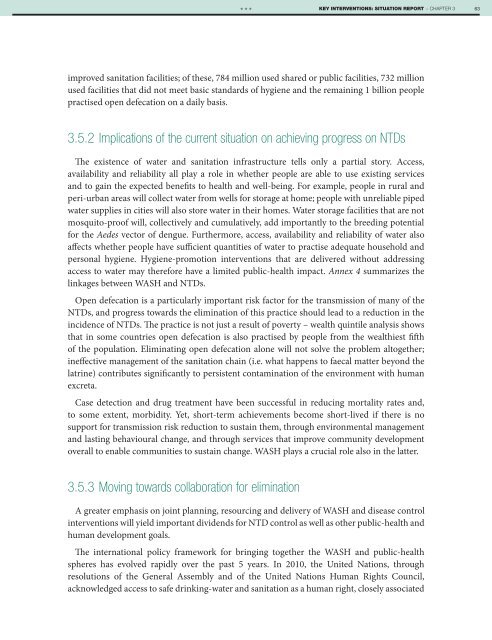1A9bnbK
1A9bnbK
1A9bnbK
Create successful ePaper yourself
Turn your PDF publications into a flip-book with our unique Google optimized e-Paper software.
***<br />
KEY INTERVENTIONS: SITUATION REPORT − CHAPTER 3<br />
63<br />
improved sanitation facilities; of these, 784 million used shared or public facilities, 732 million<br />
used facilities that did not meet basic standards of hygiene and the remaining 1 billion people<br />
practised open defecation on a daily basis.<br />
3.5.2 Implications of the current situation on achieving progress on NTDs<br />
The existence of water and sanitation infrastructure tells only a partial story. Access,<br />
availability and reliability all play a role in whether people are able to use existing services<br />
and to gain the expected benefits to health and well-being. For example, people in rural and<br />
peri-urban areas will collect water from wells for storage at home; people with unreliable piped<br />
water supplies in cities will also store water in their homes. Water storage facilities that are not<br />
mosquito-proof will, collectively and cumulatively, add importantly to the breeding potential<br />
for the Aedes vector of dengue. Furthermore, access, availability and reliability of water also<br />
affects whether people have sufficient quantities of water to practise adequate household and<br />
personal hygiene. Hygiene-promotion interventions that are delivered without addressing<br />
access to water may therefore have a limited public-health impact. Annex 4 summarizes the<br />
linkages between WASH and NTDs.<br />
Open defecation is a particularly important risk factor for the transmission of many of the<br />
NTDs, and progress towards the elimination of this practice should lead to a reduction in the<br />
incidence of NTDs. The practice is not just a result of poverty – wealth quintile analysis shows<br />
that in some countries open defecation is also practised by people from the wealthiest fifth<br />
of the population. Eliminating open defecation alone will not solve the problem altogether;<br />
ineffective management of the sanitation chain (i.e. what happens to faecal matter beyond the<br />
latrine) contributes significantly to persistent contamination of the environment with human<br />
excreta.<br />
Case detection and drug treatment have been successful in reducing mortality rates and,<br />
to some extent, morbidity. Yet, short-term achievements become short-lived if there is no<br />
support for transmission risk reduction to sustain them, through environmental management<br />
and lasting behavioural change, and through services that improve community development<br />
overall to enable communities to sustain change. WASH plays a crucial role also in the latter.<br />
3.5.3 Moving towards collaboration for elimination<br />
A greater emphasis on joint planning, resourcing and delivery of WASH and disease control<br />
interventions will yield important dividends for NTD control as well as other public-health and<br />
human development goals.<br />
The international policy framework for bringing together the WASH and public-health<br />
spheres has evolved rapidly over the past 5 years. In 2010, the United Nations, through<br />
resolutions of the General Assembly and of the United Nations Human Rights Council,<br />
acknowledged access to safe drinking-water and sanitation as a human right, closely associated


